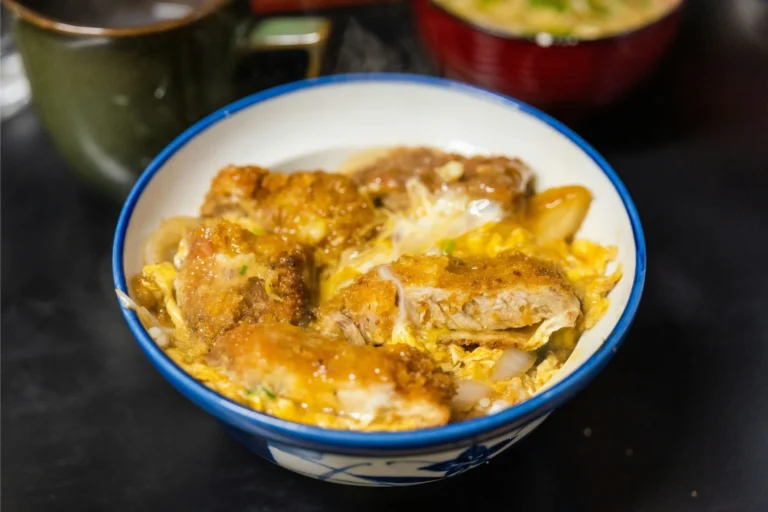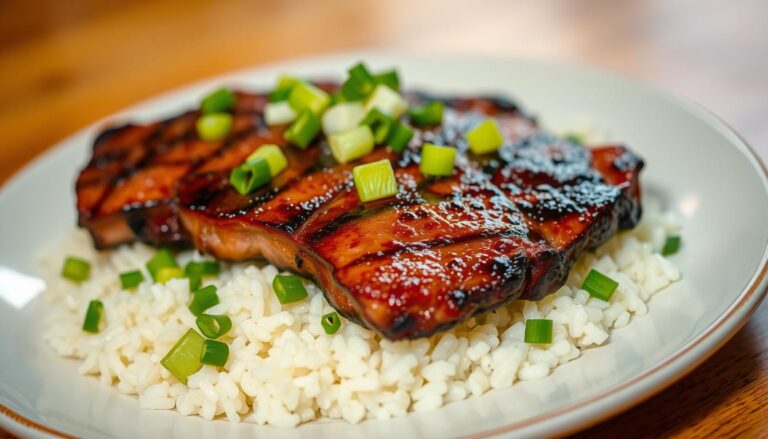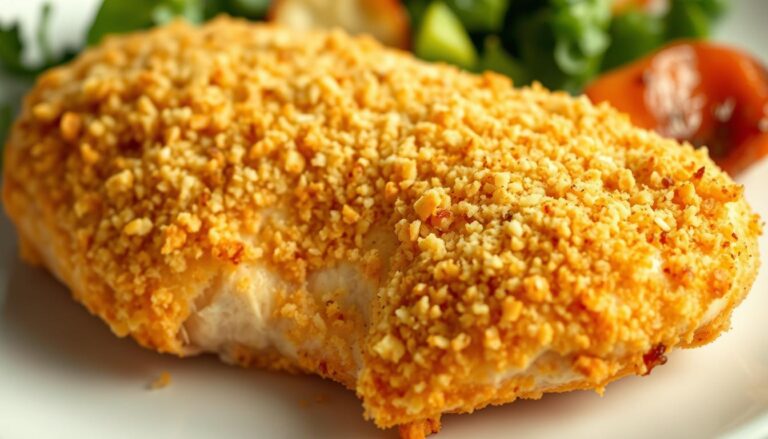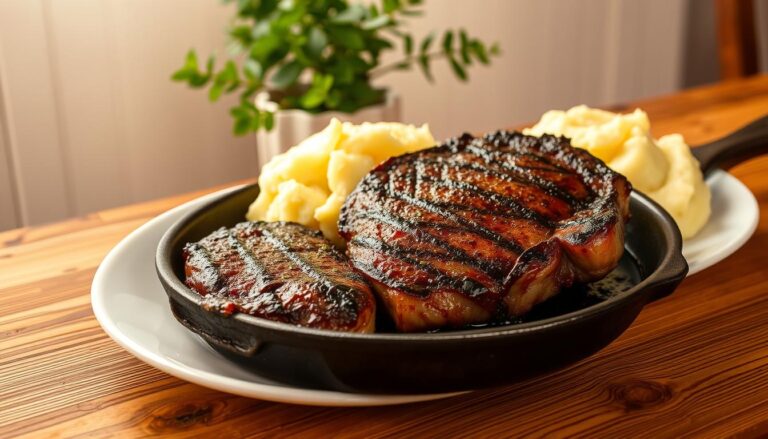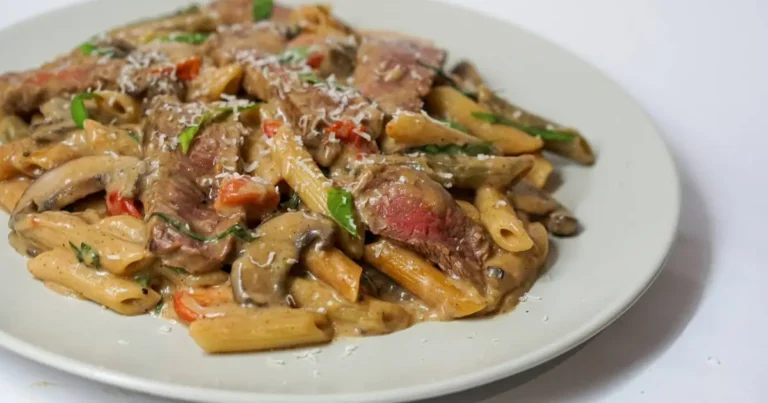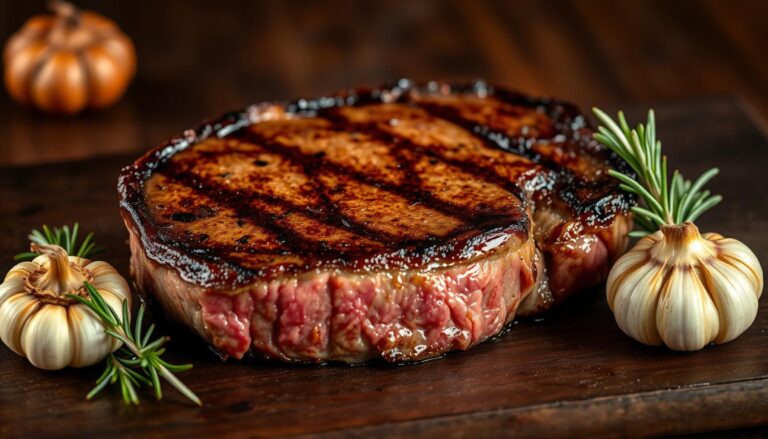Blackstone Hibachi Grill: Unlock Flavorful Outdoor Cooking
You remember that first bite at a teppanyaki table — the heat, the sizzle, the way simple ingredients became a small celebration. Now you can bring that thrill to your backyard. This guide shows you how to use your blackstone hibachi to recreate the restaurant feel at home without the steep bill.
Start with the right surface: a rolled-steel griddle needs seasoning, so keep knives off and pre-cut the chicken into bite-size pieces like chicken breast strips. Expect bold sauce flavors built on soy, garlic, and butter, and a sticky teriyaki-style glaze that clings to rice and veggies.
Plan your time and layout. Cook fried rice first, then zucchini and onions, then protein glazed in sauce for maximum flavor. Clean while warm by steaming with water and scraping to the grease trap. We’ll walk you through ingredients, heat zones, and simple recipes so you can nail consistent, restaurant-style results at home.
Table of Contents
Your At-Home Hibachi Dinner, Simplified for the Blackstone Griddle
Plan a simple sequence so every plate leaves the griddle hot and balanced.
Start with fried rice using day-old rice so kernels crisp and separate. Cook the rice first, move it to a cooler side to hold, then tackle vegetables and protein.
Keep oil, garlic, butter, and soy sauce in squirt bottles or small bowls at your side. That lets you season fast and keep a steady pace during the hibachi dinner.
Choose proteins wisely: classic hibachi chicken is a crowd-pleaser, or add shrimp for surf-and-turf. Batch on a large griddle to serve four to ten people without stress.
- Work medium to medium-high heat for searing; lower heat to hold food.
- Reserve a cooler side for fried rice while finishing chicken and veggies.
- Serve with a small bowl of yum yum for familiar steakhouse vibes.
| Course | Heat | Key ingredient | Serve size (4–10) |
|---|---|---|---|
| Fried rice | Medium | Day-old rice | 4–10 |
| Teriyaki veggies | Medium-high | Zucchini & onion, garlic | Side for all |
| Hibachi chicken / shrimp | High then hold | Chicken, soy, butter | Main, batchable |
Blackstone Hibachi: What It Is and Why You’ll Love Cooking It
A wide, even-heating flat top gives you the speed and control of a restaurant line. That makes a griddle the natural tool for hibachi-style meals at home. You get a large surface for timing, searing, and holding multiple components.
Hibachi vs. teppanyaki, plain and simple
Traditional hibachi refers to a charcoal brazier. Teppanyaki describes cooking on a flat steel plate like you see at steakhouses.
In the U.S., hibachi often means teppanyaki-style cooking — so your griddle matches the restaurant method more than the charcoal hearth.
Why a side griddle or flat top excels
A side griddle or multi-zone flat top gives you a hot searing zone and a cooler side to hold food. That lets you crisp fried rice, sear chicken pieces, and finish with a glaze without crowding the surface.
The signature flavor profile
- Soy sauce and a little sugar for savory-sweet balance.
- Garlic and fresh ginger for bright aromatics; garlic powder works as a backup.
- Butter and sesame oil to add richness and that steakhouse finish.
“Stage your ingredients and control heat, and the griddle will deliver fast, bold flavor in minutes.”
Ingredients and Tools You’ll Need for a Full Hibachi Chicken Dinner
Gather the right ingredients and tools so cooking flows without last-minute runs to the pantry. A clear setup speeds every step and keeps flavors balanced.
Proteins and vegetables
Choose lean chicken breasts for classic hibachi-style chicken, or swap in thighs and shrimp for variety. Keep zucchini and onion as your go-to steakhouse sides. Add broccoli, carrots, or cabbage if you want more color and texture.
Sauces and seasonings
Build sauces from soy sauce, minced garlic, and ginger with a touch of brown sugar or honey. Use sesame oil for flavor and a neutral oil in squeeze bottles for quick re-oiling. Keep salt and pepper and garlic powder for finishing.
Rice, eggs, and aromatics
Day-old rice is essential for fluffy, non-gummy fried rice. Stage eggs, green onion, and a small bowl of aromatics so you can finish the rice fast.
Griddle setup and essentials
Arrange a hot zone for searing and a cooler side to hold rice and veggies. Set out spatulas, a bench scraper, squeeze bottles, and a trash pan. Pre-cut the chicken into bite-size pieces and have garlic butter ready to flavor rice, veggies, and chicken.
| Item | Purpose | Suggested amount (4–6) |
|---|---|---|
| Chicken breasts | Main protein, lean | 2–3 breasts |
| Zucchini & onion | Steakhouse sides | 2 zucchini, 1 large onion |
| Day-old rice | Fried rice base | 4 cups cooked |
| Squeeze bottles & spatula | Speed and control on the griddle | 2–3 bottles; 1 spatula |
“Stage a bowl of aromatics and tools before you heat the griddle — it saves time and flavor.”
Step-by-Step: Make Hibachi on the Blackstone Like a Pro
Work in a tight sequence so each plate leaves the griddle hot and perfectly timed. Follow the order below to keep textures bright and flavors bold. Short bursts of high heat, then holding on a cooler side, is the key.
Fried rice first
Heat oil on the griddle, add aromatics, then toss in day-old rice. Season with a splash of soy and press for a few minutes to form crisp bits.
Move the fried rice to the cooler side to hold while you finish other components.
Teriyaki veggies
Sauté zucchini and onion in oil and garlic butter. Season with salt, pepper, and garlic powder.
Spread the veggies to maximize sear, toss occasionally, and pull when they’re tender-crisp. Add a splash of soy to finish.
Hibachi chicken
Arrange bite-size chicken pieces in a thin layer on the hot griddle. Sear until edges color, then add a pat of butter and cook until almost done.
Whisk a quick glaze of soy, brown sugar or honey, garlic, and ginger. Add the glaze in the final 1–2 minutes and stir constantly so sugars don’t burn.
Optional add-ons and timing
Shrimp cook fast—about 2–3 minutes per side until opaque. Sear steak on open space, slice off the griddle, and return to glaze if desired.
Plating and serving
Family-style works best: mound fried rice, top with veggies and chicken, and garnish with sesame seeds and lemon wedges. Serve immediately with dipping sauces so everyone customizes their plate.
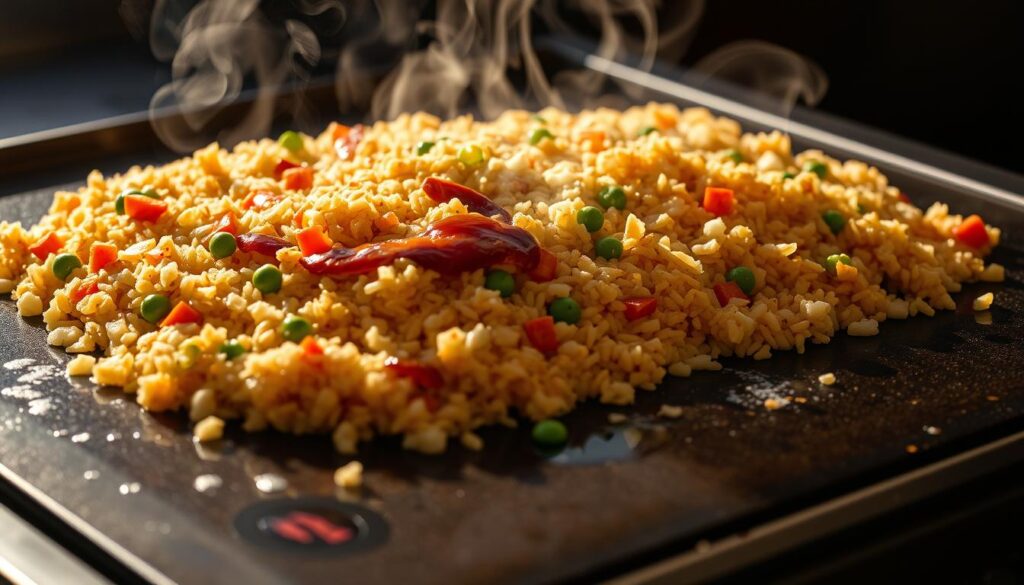
“Stage your work and keep the griddle moving—timing beats speed every time.”
Hibachi Sauces and Garlic Butter You Can Whip Up at Home
A few quick sauces lift plain chicken and rice into flavors you’ll want to repeat. Below are easy mixes that finish food on the griddle and make plating feel like a restaurant service.
Sticky-sweet teriyaki-style coating for chicken on the griddle
Whisk soy sauce with brown sugar, honey, minced garlic, and ground ginger. Add the glaze in the last one to two minutes on high heat so it thickens and clings to the chicken.
Yum yum, ginger, and spicy mustard dips for restaurant vibes
Mix yum yum sauce ahead and let flavors meld in a small bowl. For variety, make a ginger sauce with soy, rice wine vinegar, onion, lemon, sugar, and fresh ginger. A spicy mustard dip blends roasted sesame, dry mustard, soy, garlic, and cream.
Garlic butter: a simple flavor booster
Beat softened butter with garlic paste and a pinch of salt. Brush it on rice, veggies, or proteins right off the griddle for instant richness.
- Tip: A splash of sesame oil deepens aroma in any sauce.
- Keep sauces in squeeze bottles or ramekins for fast service at the griddle.
- Many cooks use bottled Japanese barbecue as a shortcut—works fine in a pinch.
“Whisk, taste, and adjust—small changes in sweetness or salt make big differences.”
blackstone hibachi Cook Times, Heat Zones, and Pro Tips
Plan your cook line by mapping zones and timing so every plate finishes hot. Set a clear hot sear area and a cooler side to hold rice or finished veggies. That simple layout saves you minutes and keeps textures right.
Mise en place and heat management: cook sequence and space control
Map your time with a reliable sequence: fried rice first, then shrimp, then steak or chicken, and finish with veggies—or rice, veggies, then chicken if you prefer. This avoids overcooking and keeps sauces from burning.
- Shrimp: about 2 minutes per side; watch for opaque flesh.
- Steak: 3–4 minutes per side for medium-rare (130–135°F).
- Chicken: cook to 165°F and keep raw chicken and steak several inches apart to prevent cross-contamination.
- Cut proteins on a board—not the griddle—to protect seasoning and avoid knife marks.
Keep a spatula and bench scraper handy to move food and clear debris. Season in layers—salt, pepper, soy, and a brush of garlic butter—to build flavor without oversalting.
Cleanup made easy: steam, scrape, re-oil while the griddle is warm
Clean as you go: squirt water into hot areas to create steam, then scrape residue into the grease trap. If a sauce thickens or scorches, lower the heat and keep food moving.
After scraping, wipe and apply a thin film of oil while the surface is still warm. That light coat preserves the seasoning and shortens setup time for your next recipe.
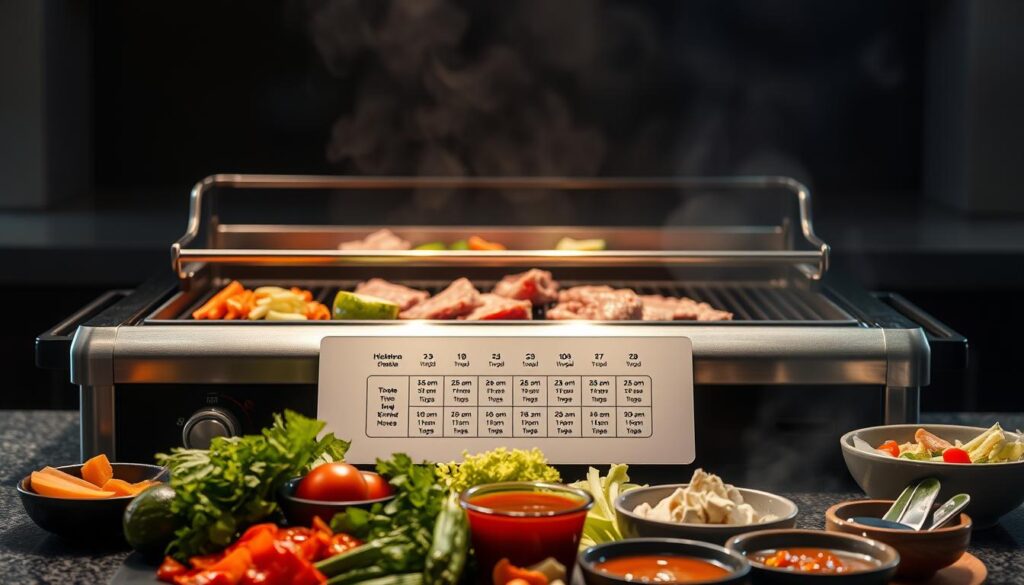
“Establish zones and respect cook times—it’s the difference between good and great griddle food.”
Variations, Substitutions, and Serving Ideas
Turn one base recipe into several meals by switching proteins and finishing sauces. That approach keeps your hibachi dinner fresh and lets you cook to taste.
Protein swaps: Swap chicken breast for thighs, shrimp, steak, salmon, scallops, or tofu. These proteins all take well to quick searing and the same seasoning. Combine chicken with shrimp for an easy surf-and-turf that impresses.
Veggie lineup: Build color and texture with broccoli, mushrooms, carrots, peppers, zucchini, bean sprouts, or snow peas. Toss them in oil and finish with a splash of sesame oil before plating.
Serving a crowd and leftovers
Batch components: fry rice first, hold on a cooler side, then finish proteins in rounds. Plate on large bowls or platters for self-serve hibachi dinner vibes.
| Task | Yield | Storage |
|---|---|---|
| Serve size (large griddle) | 8–10 with helper | — |
| Leftovers | Refrigerate up to 1 week | Freeze up to 3 months |
| Reheat | Air fryer or microwave | Crisps fried rice best in air fryer |
“Batch, hold, and finish—then let guests customize plates with yum yum and soy sauce.”
Conclusion
Finish strong with a reliable sequence. Follow the fried rice, veggies, then chicken flow so every plate leaves the griddle hot and balanced.
Lean on the griddle’s space to set hot and cool zones, move food fast, and serve within minutes. Use day-old rice for the best fried rice texture and hold it while you finish proteins.
Keep flavor centered on soy, garlic, ginger, butter, and sesame oil. Make sauces like yum sauce and ginger dip ahead, and drop garlic butter at key moments to boost aroma.
Protect the surface: don’t cut on the griddle, steam and scrape while it’s warm, then wipe and oil. Save your favorite fried rice recipe and timing notes so you can make hibachi at home again and again.


